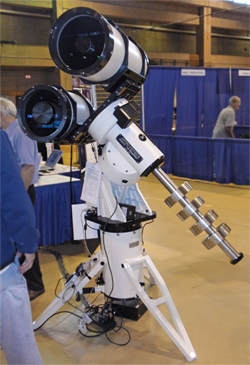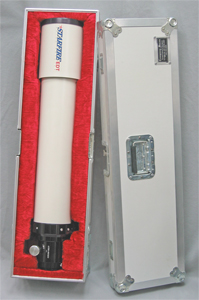Availability
![]() Distribution
Distribution
![]() News
News
![]() Notes
Notes
![]() Overview
Overview
![]() Pricing
Pricing
![]() Products
Products
Accessories and Options
![]() Mounts
Mounts
![]() Mount Control Systems
Mount Control Systems
![]() Telescopes
Telescopes
Astro-Physics 305mm f3.5 / 12 Inch f3.8 Riccardi-Honders Astrographic Telescope (P/N 305RHA)
An amazing 1,160mm f3.8 Apo Lens!

Above: Astro-Physics 305mm Honders telescope side view with Dewcap and optional SBIG CCD system attached (82,701 bytes) |
Development of the Riccardi-Honders Design
Astro-Physics Company are known for making the world's most advanced, versatile, and desired lines of apochromatic refractor telescopes. In 2000 after more than a decade of research and development to "get it right" they surprised the astronomy community with the announcement of their first production Catadioptric telescope. This is designated the Astro-Physics Astro Physics 10" f14.6 Maksutov-Cassegrain telescope, a compact 33 lb. (15 kg) high resolution instrument designed to provide refractor like views (and images) of the brighter, small objects including the planets, moon, double stars, and the like.
Right: Astro-Physics 305mm Honders telescope (OTA to the left) as introduced in 2009 atop the Astro-Physics 3600GTO 'El Capitan' German Equatorial Mount (79,387 bytes). Image courtesy of David Illig.
Click on image to see enlarged view (253,556 bytes).
Since then Astro-Physics has been working to perfect a new catadioptric telescope, one ideally suited for imaging wide areas of sky and not compromised by considering visual applications. This new telescope would be compact, perform well in temperature extremes around the world, and meet their traditional exacting requirements for optical and mechanical excellence. The result is a telescope that is the first of its kind: the Astro-Physics 305mm f3.8 Astrograph. The 'Honders" as it is known here at Company Seven and in most of the community is based on Klaas Honder's original idea of a fast optical system using a crown glass objective and meniscus correcting mirror in a Newtonian configuration. By adding a secondary mirror and field lens, Italian designer Massimo Riccardi was able to design an ultra-fast (short focal ratio) astrograph using only comparatively affordable crown glass elements. Astro-Physics has added their more than years of telescope design experience to create a truly unique and fast astrograph to take full advantage of today's CCD imaging cameras. With this telescope you will collect photons most efficiently producing wide-field of view images that you could previously only have imagined.
A further goal in this development effort was to equal or to approach the performance of their highly prized triplet apochromatic refractors in at least certain applications. One thought in producing these Catadioptric telescopes is that if a number of customers who do not require the versatility of the Apo refractors (which perform superbly well at extremely high magnifications, and down to very low magnifications) will order the Mak telescopes instead of the triplet Apos then this may take some of the burden from the Triplet production line, and thereby help Astro-Physics to satisfy a far greater number of the more demanding amateur and professional clientele.
In April 2008 Roland Christen had presented a paper entitled "Optical Design for High Resolution Imaging" discussing the advantages of the Riccardi-Honders optical design. The prototype 305mm f3.8 Riccardi-Honders Astrograph prototype was introduced to the public on 18 April 2009 (image at right) although by then it had already proved itself with numerous amazing images taken while at the Astro-Physics observatory. It was shown mounted in parallel with the prototype
The system includes the optical tube assembly, a 3.5 inch diameter focuser, Dewcap (Lens Shade), Dust Cover, pair of Mounting Rings, and Carrying Case. Company Seven will offer an optional Airline Transport Association Approved (ATA) shipping case for this instrument.
Any optical imperfections such as a degree of surface roughness and zonal errors on the optical surface will compound the problem.
Astro-Physics tested a commercial telescope where the central obstruction, optical errors and surface roughness were large enough to cause the first diffraction ring and central Airy disc to have almost equal brightness (with a 35% obstruction, theoretically there should be at least a
4 to 1 difference). Even so, this sample telescope "tested" very well on the star test - it had quite similar inside and outside Fresnel patterns and might be judged to be textbook perfect by the star test. Yet it was a very poor performer on all but the most steady of nights, when the seeing was essentially perfect. The slightest motion in the atmosphere would result in a display of "cotton ball" stars. This is one reason why
Astro-Physics and Company Seven have not been a major fans of the "star test" to evaluate the actual performance of a telescope. The only unbiased way to measure an optic is with interferometry, or by an MTF (modulation transfer function) test, or with a PSF (point spread function) test, which measures the relative strength of the Airy disc versus the diffraction rings with the image in focus.
Astro-Physics has endeavored to achieve the highest absorption of stray light possible by employing state of the art baffling and anti-reflection techniques; this will help to provide the user with maximum contrast. The exterior of the telescope is finished in a durable textured off white finish, with black anodized focuser and cells; these will retain their beauty for many years. You will appreciate the unique design and fine craftsmanship of this telescope.
Knife edge baffles are machined into the walls of the telescope optical tube and of the focuser draw tube, these and painted flat black in order to maximize contrast by essentially eliminating any internal reflections. The inside diameter (I.D.) of the draw tube permits the avid astrophotographer to employ up to a 35mm format film or CCD camera to capture images. While this is designed as an astrographic instrument, you can attach a Barlow lens then attach standard 2 inch diameter accessories, and with the furnished 1.25 inch adapter (threaded for 48mm filters) to use common oculars and accessories too. Recessed brass locking rings are installed at each thumbscrew location; as you tighten a thumbscrew a brass locking ring clamps onto the part that has been inserted; consequently the focuser draw tube and any accessories are held securely in place and will not mar the surface of your accessories. This is particularly important considering the heavy and expensive accessories that you may use.
* Specifications are subject to change without notice.
Right: Company Seven ATA Case custom fitted for a Astro-Physics 13cm EDT Apochromat Telescope with 2.7 inch Focuser (65,974 bytes).
Features include:
Left: Astro-Physics Model 900 Mount in optional Company Seven ATA case.
OPTICAL CHARACTERISTICS
The Astro-Physics design is a modified Riccardi-Honders featuring diffraction-limited performance over a huge three (3) degree field; this is ideal for capturing immense faint emission nebulae. The coverage is uniform over a wide wavelength range providing essentially perfect color correction from 400 to 1,000 nanometers (UV to IR). The telescope is fully corrected for all five Seidel aberrations (spherical, coma, astigmatism, field curvature and distortion), as well as longitudinal and lateral chromatic aberration. Multi-coatings on all optical elements ensure high throughput providing very high-contrast images.
Consider these advantages:
After years of experimenting with 8" and 10" telescope prototypes, Astro-Physics have found very effective ways to rapidly cool down the optics for stable high-power viewing. They have been testing this 12" and other Catadioptric designs for more than a decade, and in a variety of environments from warm summer nights to bitter cold winter conditions with rapidly falling temperatures. To minimize thermal gradients and help the mirror shed its heat, Astro-Physics designed a special open mirror cell assembly. Cool night air can flow across the back of the mirror. To further speed up the cooling process in the most extreme conditions, the telescope is provided with two small fans which can be operated at full speed, or at a slow whisper quiet speed. The air blows directly at the back of the mirror - no air goes inside the tube and cannot cause particulate contamination of the mirror surfaces.
Much has been written pro and con about the need for a small central obstruction. While the light loss of a secondary obstruction is in fact quite small even in telescope with a large obstruction, there are undesirable diffraction effects which will be in direct proportion to the obstruction size.
Astro-Physics observations while using many types of optical systems for more than twenty years have convinced them of the desirability of relatively small obstructions for visual systems however, this is less of a concern in short focal length astrographic systems where stars will be much smaller owing to the comparatively smaller image scale.
Typically the commercial "production" catadioptric telescopes have overall obstructions of between 35% to 40% (and this includes some
Maksutov-Cassegrain designs also). This level of obstruction produces a noticeable reduction in the amount of light concentrated in the central Airy disc, and a subsequent increase in the brightness of the first, second and higher diffraction rings even when the optics are perfectly figured. When the atmosphere becomes unsteady, more and more energy is thrown out from the central Airy disc into the diffraction rings. As the seeing degrades, at some point the Airy disc merges with the first and subsequent diffraction rings to form an indistinct fuzzy blob. This degradation of the image happens much more frequently in a larger obstructed system where the diffraction rings already contain a large percentage of the incoming energy.
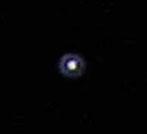
Above: High power image of Vega taken with 10" Mak using an Olympus DL600 digital camera. Seeing was 7 out of 10. Shown is Airy disc and first diffraction ring. (980 bytes)
The Astro-Physics 10" Mak-Cass optics are fabricated by skilled opticians. The optics are hand figured to 1/10 wave (Peak to Valley) using a green light interferometer in a double-pass mode. The end result is an optical system that does what it is supposed to do - produce unparalleled views of the planets and deep-sky objects with good thermal performance under actual night-sky conditions.
MECHANICAL CHARACTERISTICS
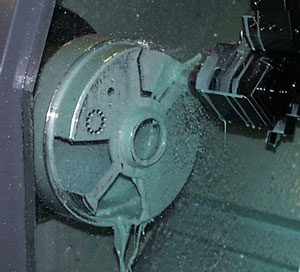
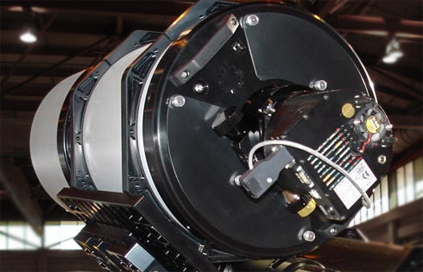
Completed telescope showing rear cell (with optional SBIG CCD system attached). Note machining of the Mounting Rings to reduce weight (54,490 bytes).
The Astro-Physics telescope optical tube assemblies were designed right from the start with trouble-free precision being the dominant goal. This means the optical collimation is set at the factory and does not change for the life of the instrument. To achieve this, all optics are accurately centered, including the mirror backs. All mounting components are made from solid billets - no fragile die castings are used anywhere! The critical mirror cell starts out as a solid 12 inch (304.8 mm) diameter aluminum slug weighing in excess of 30 lb. (13.6 kg). It is then precisely machined to very tight tolerances on
Astro-Physics in house Mori-Seiki Model SL300 computer controlled turning center. The finished mirror cell with its ventilation cutouts weighs a fraction of its original weight. The other 20+ lbs. (9.1+ kgs) in the form of chips is, of course, recycled. Similar care is taken with the cell for the corrector lens and other mounting components. The result is a telescope which you can count on to produce consistently excellent images any time, any place.
This is a fixed mirror focus design, so in order to best accommodate a wide variety of photographic accessories the telescope. The focuser can be removed and third party equipment can be attached. The goal was to achieve precise focus of the system down to the micron level with absolutely no image shift. To accomplish this, Astro-Physics designed a cell that supports the primary mirror, with no off-axis shifting as is done in the majority of commercial catadioptrics. There is no need to lock the mirror down with external bolts to keep it from shifting during a time exposure. The focuser (or other attachment hardware put in place of the provided focuser) assures your image will stay on that CCD chip regardless of focus position. Best of all, the mirror maintains its precise collimation and will not shift or flop around as you slew the telescope from one part of the sky across to the other.
305mm f/3.8 - 12 Inch f/3.8 TELESCOPE SPECIFICATIONS:
Color correction:
Less than 0.01% focus variation from 1060nm to
400nm
Clear aperture:
305 mm (12 inches)
Effective focal length:
1,160mm (45.6 inches)
Focal ratio:
3.8
Secondary Diameter:
5.9 inch (149.9 mm), 24% by area
Airy Disc:
0.28 microns
Resolution:
0.38 arc seconds
Field size:
Diffraction-limited over 3.0 degree field - 60mm circle
35mm prime-focus field:
0.54 x 0.37 x 0.66 degrees
Mirror Coatings:
Enhanced and Protected Aluminum,
96% transmission in peak visual wavelengths
Corrector Lens Coatings:
Broad band multi-coatings on both surfaces (r1 and r2)
Focuser type:
3.5 inch Dia. Rack & Pinion (removable)
Back Focus (w/Focuser):
3.95 inch (100mm)
Back Focus (w/o Focuser):
6.38 inch (162mm)
Focus Range:
1.15 inch (29mm)
Focuser Length:
4 inches
Focuser Gearing:
FeatherTouch Micro 9:1 dual-speed reduction
Focuser Drawtube Travel:
1.4 inch (36mm)
Focuser Adapters Provided:
2.7, 2 and 1.25 inch
Optical Tube length:
21 inches (53cm) without dewcap or focuser
Optical Tube diameter:
12 inches (30.5cm)
Dewcap / Lens Shade (D x L):
14.92 x 15.28 inches (37.9 x 38.8cm)
Optical Tube Weight w/Focuser:
58 lbs. (26.2 kg)
Optical Tube Duscover Weight:
3 lbs. (1.6 kg)
Dewcap / Lens Shade Weight:
7 lbs. (3.2 kg)
Tube assembly:
Cream White/Black finish, aluminum tube fully baffled,
permanently aligned cell construction, engraved focuser
Mounting Rings:
2.5 lbs. (1.1 kg) each
Mounting Rings Top:
10-32 tapped holes spaced 3.00",¼-20 center hole
Mounting Rings Bottom:
¼-20 tapped holes, spaced: 2.362", 3.20", 4.5" and center hole
Carrying case (OTA w/Focuser):
hard case with cushioned cradle, removable wheels
Case outer dimensions:
29 x 19-½ x 19 inches (73.7 x 49.5 x 48.3 cm)
Case weight:
40-½ lbs. (1.6 kg)
FEATURES OF THE OPTICS
FEATURES OF THE TUBE ASSEMBLY AND ACCESSORIES
SUGGESTIONS
Click on image to see enlarged view (215,942 bytes).
Case 1 of 2 shown here, with Declination housing (left side shown) with GTO Keypad Controller
and Counterweight Shaft (94,326 bytes).
Contents Copyright 1994-2010 Company Seven - All Rights Reserved


